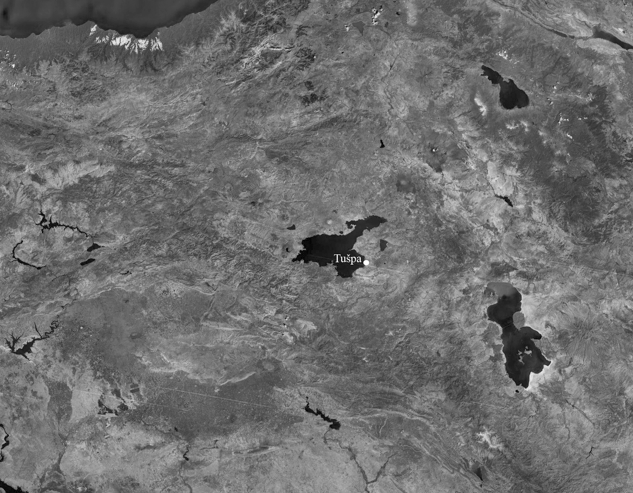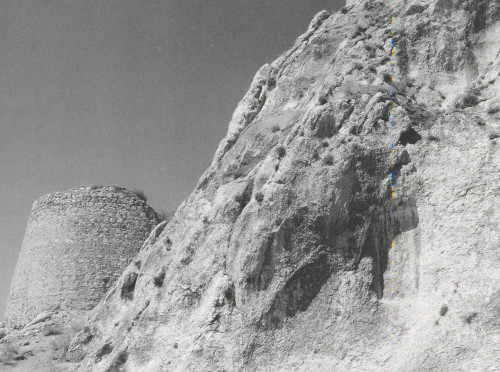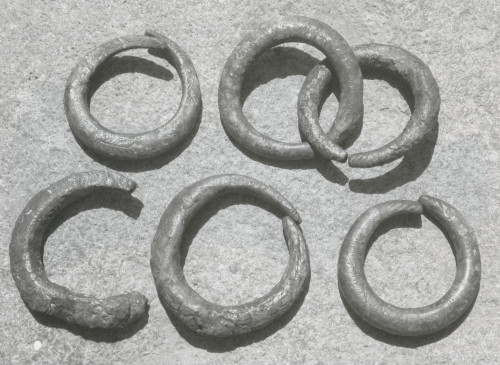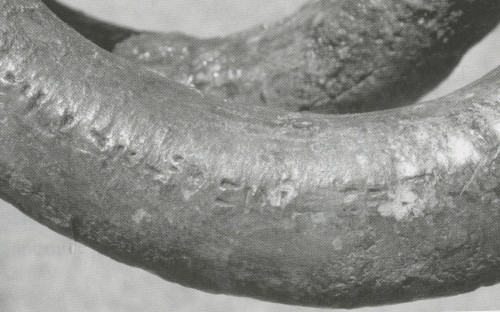Išpuini, Minua, and Inušpua
Among the inscriptions of Išpuini, Minua and Minua's son Inušpua there is one rock inscription while the other texts are inscribed in bronze and silver object.

Map showing the distribution of the stone inscriptions of Išpuini, Minua, and Inušpua, in: Mirjo Salvini, CTU I: 176
Royal titles
There are no royal titles given in any of the inscriptions mentioning Išpuini, Minua and Išpuini.
Building activities
The rock inscription A 04–01 which is located in Tabriz Kapısı on rock Van is composed as a speech of Išpuini that reports the erection of a tower temple and a gate for the god Haldi by Minua and Inušpua in or near the city Ṭušpa. Furthermore, the text reports that the erection of the buildings was accompanied by sacrifices.

Rock inscription of Tabrız Kapısı (A 04-01), in: CTU III: 103
Interestingly, no reference is made to a participation of Išpuini, neither in the building projects nor in the sacrifices. Apart from his role as the one giving the report, Išpuini is only mentioned as beneficiary in the blessing formulae along with Minua and Inušpua.
Another text that refers to joint activities of Išpuini, Minua and Inušpua is the inscription B 04–01 which is engraved in four bronze rings (duplicates A–D). According to it, Išpuini, Minua and Inušpua dedicated the rings after their conquest of the territory of the city Amuša. The military campaign therefore must have taken place in the later years of Išpuini's reign or, respectively, during the putative coregency of Išpuini and his son Minua (for further information see the portal page Išpuini and Minua).

Bronze rings with votive inscription of Išpuini, Minua, and Inušpua from Yukarı Anzaf, photo: Mirjo Salvini, CTU IV: 27

Votive inscription of Išpuini, Minua, and Inušpua on bronze rings from Yukarı Anzaf, photo: Mirjo Salvini, CTU IV: 27
All these inscriptions suggest that Inušpua was initially intended as Minua's successor, and not his brother Argišti I. Whether Inušpua has ever come into power remains unclear. Except for the inscriptions that mention him along with his grandfather and father, he is only mentioned in the dedicatory inscription B 02–04 on a silver bucket. The text states that Išpuini gave the bucket to Inušpua as a present because of his affection for his grandfather (see portal page Išpuini).
It is therefore likely that Inušpua reigned only for a short period, or that his brother Argišti I immediately followed his father on the thrown. The reason for this remains unclear. A struggle over the succession and a forceful death of Inušpua cannot be excluded. But since no attempts have been made to eradicate his name from the inscriptions and thereby erase him from the collective memory, it appears more likely that he died before ascending the throne or soon afterwards.
Further reading
Birgit Christiansen
Birgit Christiansen, 'Išpuini, Minua, and Inušpua', Electronic Corpus of Urartian Texts (eCUT) Project, The eCUT Project, 2018 [http://oracc.museum.upenn.edu/ecut/urartianrulersandchronology/ishpuiniminuaandinushpuaa04/]